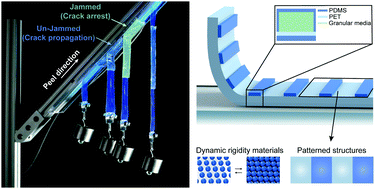Deterministic control of adhesive crack propagation through jamming based switchable adhesives†
Abstract
Controlling delamination across a material interface is a foundation of adhesive science and technology. This ranges from creating permanent, strong adhesives which limit crack propagation to reversible adhesives which initiate cracks for release. Methods which dynamically control cracks can lead to more robust adhesion, however specific control of crack initiation, propagation, and arresting is challenging because time scales of crack propagation are much faster than times scales of mechanisms to arrest cracks. Here we show the deterministic control of crack initiation, propagation, and arresting by integrating a granular jamming layer into adhesive films. This allows for controlled initiation of a propagating crack by reducing rigidity and then rapidly arresting the crack through jamming, with a rise in stiffness and an 11× enhancement in adhesion. This process is highly reversible and programmable, allowing for numerous crack initiation, propagation, and arresting cycles at arbitrary selectable locations in a peeling adhesive. We demonstrate this crack-control approach in single and multiple peel directions under fixed load conditions in response to diverse pressurization input signal profiles (i.e. time varying propagation and arresting scenarios).

- This article is part of the themed collection: 2021 Soft Matter Emerging Investigators


 Please wait while we load your content...
Please wait while we load your content...